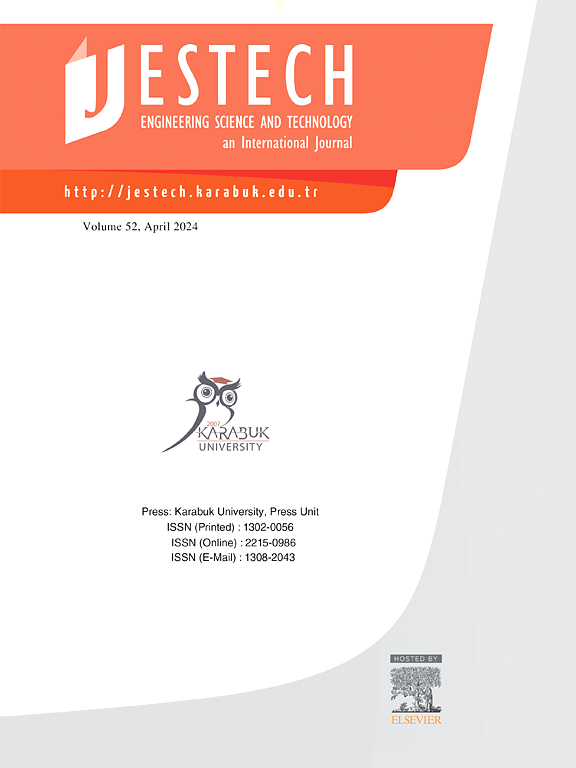Effect of polarization potential on tribocorrosion behavior of duplex stainless steel UNS S32205 in NaCl solution
IF 5.1
2区 工程技术
Q1 ENGINEERING, MULTIDISCIPLINARY
Engineering Science and Technology-An International Journal-Jestech
Pub Date : 2025-03-27
DOI:10.1016/j.jestch.2025.102047
引用次数: 0
Abstract
This study explores the effects of anodic, cathodic, and open circuit (OCP) potentials on the tribocorrosion behaviour of the UNS S32205 duplex stainless steel, which is largely used in oil, gas, and cellulose industry. For this purpose, tribocorrosion assays using a contact sphere (Si3N4) against the specimen plane in reciprocating sliding movement in 0.5 M NaCl solution were carried out. For comparison purposes, cathodic polarization or tests without applied potential under distilled water (DW) were used to inhibit corrosion for tribocorrosion tests. Two main distinct behaviours were observed: i) high coefficients of friction and lower wear volumes at the cathodic polarization (CP) for conditions smaller or equal to –0.8 V (vs Ag/AgCl 3 M) as well as in DW; and ii) low coefficients of friction and higher wear volumes for anodic polarization (AP), OCP, and CP for –0.4 V. The tribocorrosion behaviour of both groups was directly related to the chemical characteristics inside the tracks analyzed using SEM-EDS and Raman spectroscopy. All analyzed tracks showed similar oxygen contents and chemical compositions within each group. Finally, this study allowed the determination of the great effect of the potential applied on the tribocorrosion behaviour and the identification of differences between the cathodic protection and distilled water assays as methods to inhibit corrosion.
求助全文
约1分钟内获得全文
求助全文
来源期刊

Engineering Science and Technology-An International Journal-Jestech
Materials Science-Electronic, Optical and Magnetic Materials
CiteScore
11.20
自引率
3.50%
发文量
153
审稿时长
22 days
期刊介绍:
Engineering Science and Technology, an International Journal (JESTECH) (formerly Technology), a peer-reviewed quarterly engineering journal, publishes both theoretical and experimental high quality papers of permanent interest, not previously published in journals, in the field of engineering and applied science which aims to promote the theory and practice of technology and engineering. In addition to peer-reviewed original research papers, the Editorial Board welcomes original research reports, state-of-the-art reviews and communications in the broadly defined field of engineering science and technology.
The scope of JESTECH includes a wide spectrum of subjects including:
-Electrical/Electronics and Computer Engineering (Biomedical Engineering and Instrumentation; Coding, Cryptography, and Information Protection; Communications, Networks, Mobile Computing and Distributed Systems; Compilers and Operating Systems; Computer Architecture, Parallel Processing, and Dependability; Computer Vision and Robotics; Control Theory; Electromagnetic Waves, Microwave Techniques and Antennas; Embedded Systems; Integrated Circuits, VLSI Design, Testing, and CAD; Microelectromechanical Systems; Microelectronics, and Electronic Devices and Circuits; Power, Energy and Energy Conversion Systems; Signal, Image, and Speech Processing)
-Mechanical and Civil Engineering (Automotive Technologies; Biomechanics; Construction Materials; Design and Manufacturing; Dynamics and Control; Energy Generation, Utilization, Conversion, and Storage; Fluid Mechanics and Hydraulics; Heat and Mass Transfer; Micro-Nano Sciences; Renewable and Sustainable Energy Technologies; Robotics and Mechatronics; Solid Mechanics and Structure; Thermal Sciences)
-Metallurgical and Materials Engineering (Advanced Materials Science; Biomaterials; Ceramic and Inorgnanic Materials; Electronic-Magnetic Materials; Energy and Environment; Materials Characterizastion; Metallurgy; Polymers and Nanocomposites)
 求助内容:
求助内容: 应助结果提醒方式:
应助结果提醒方式:


